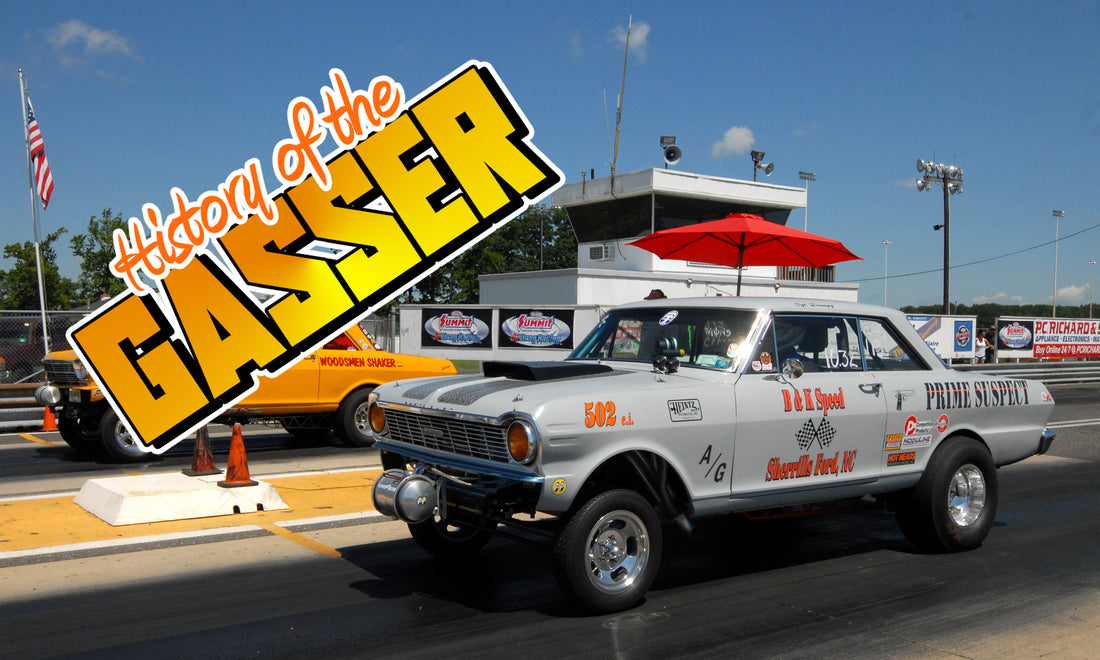History of the Gasser
Gasser can have a lot of meanings, from an amazingly funny joke to a person who is loud and likes attention. The automotive world has a completely different kind of gasser. We'll explore the history of gassers – which is a term for modified cars. We'll look at how the gasser came about and what makes them a part of automotive history as well as what is happening with them today.

Vintage Drag Racing
One of the general themes of 1950's and 1960's automotive history was the desire to go fast. The question was often a matter of how to increase speed. A “gasser” involves a few modifications to an already produced vehicle. Racers would replace engines – or at least part of the engine — with one from a vehicle with a bigger, more powerful motor. These motors also ran on gasoline, which sounds very normal today, but at the time, it wasn't uncommon to run a vehicle off some form of ethanol or even nitro.
While many drivers of vintage vehicles lament the loss of style from vehicles built before the 1970s, the racers who 'made' gassers actually disassembled part of what made those vehicles unique. They could commonly replace or remove grilles, bumpers, and hoods and replace them with lighter weight fiberglass – or not replace them at all. Why? Weight! The vehicles could already go reasonably fast, but removing a few hundred pounds of decoration – or safety equipment – helped the vehicles move a bit faster.

Modifying the inside wasn't out of the question. Just like modern race cars and drag racers, the interior could be minimal. Knowing that many vehicles had a front bench seat, they could be modified to only be bucket seats or less. Some vehicles were stripped down to the frame to spare no additional weight.
Gassers really stood out because of their stance. As vehicles known for straight line acceleration, the front could be lifted to ensure as much traction with the rear tires as physically possible. This involved using a straight beam front axle that was lighter than those original to the vehicle.

While not noticeable to everyone, a common modification also involved routing the exhaust near one of the front wheels. This helped to keep the exhaust lighter, keep it off the ground, and made for a distinct look.
The most commonly modified vehicles for the purpose were the 1957 Corvette, the 1949 Chevy Fleetline or Styleline, Studebaker pickups, and definitely a few more, including Willys.

Origins
While the actual “inventor” of the gasser is debated, it is believed that Timothy Woods and Fred Stone, who were managers for a construction company, made the first gas drag race cars. Word of the idea spread quickly and became a small time competitive event until they earned their own National Hot Rod Association class based on total engine horsepower.
Origin stories vary in part because of the variety of words used to describe the gasser. You also have a Kamikaze Koup (in truth, not a bad name for a vehicle with only a drivers seat, a lift, and no bumpers), Assassination, Agitator, and King Kong.
Gassers became more directly involved in NHRA when the NHRA banned nitro burning vehicles from 1957 to 1963. As gas powered vehicles, they had to take center stage.

Amongst the biggest advantages to the gasser at the time was that anyone with mechanical knowledge could make a gasser. They often used regular family vehicles, which were relatively cheap between the 1930s and 1950s.
Gassers Today
Gassers are more commonly driven in reunion or nostalgia races. Gassers were more prevalent in the 1990s and were a major part of racing clubs. There are fewer active racing circuits today but with some effort – and potentially some travel — you'll find one. Today, car shows and events like the Race of Gentlemen are becoming popular.

Since nearly all vehicles today run on regular gas, they aren't quite as common, though their distinct look and internals certainly stand out from today's intentionally aerodynamic race vehicles.
When considering buying a gasser, also be aware that many of them were built in someone's garage, so the values associated with a gasser can be very confusing – much like a lift truck.

